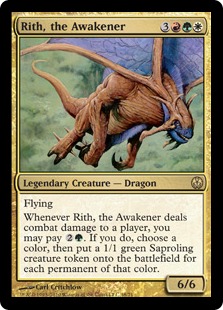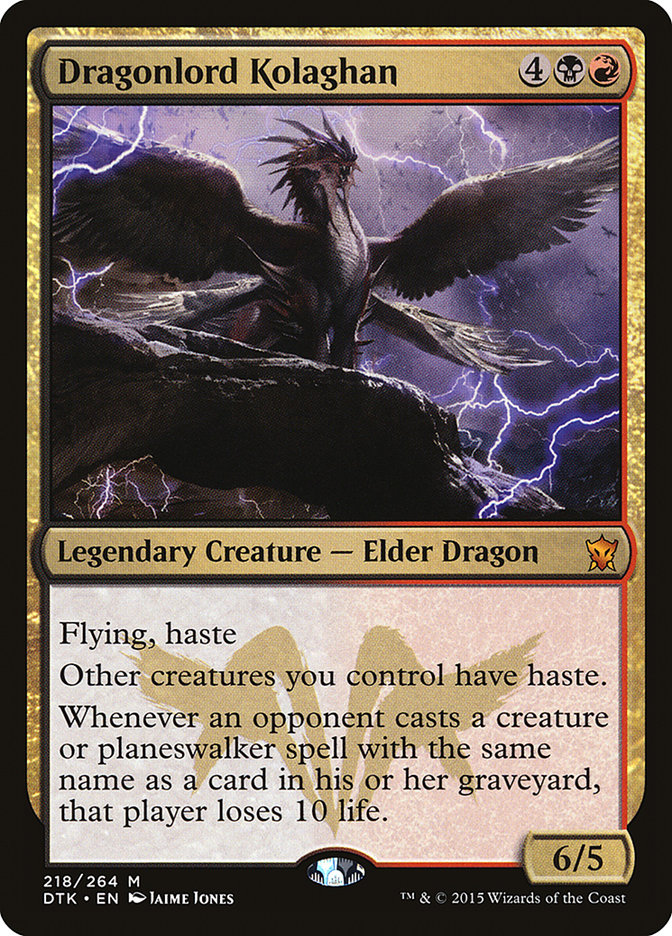Welcome back, loyal readers! As you’ve seen, there’s been a bit of a shakeup in Azami’s scroll room, and it’s awesome. Sean will be missed, although the
projects he’s stepped away to work on all sound fascinating, and you should definitely keep your eyes open for them. Cassidy has made his triumphant return,
and the Innovator, Patrick Chapin, doctored a deck for us for our 200th column. That’s a lot of columns!
Being part of something this big makes me feel powerful. Do you know what else makes me feel powerful? Dragons! Sarkhan might be a putz for screwing with
the timeline on Tarkir, but I do get the draconic appeal. When I was a kid, I used to dream about being a shape-changing dragon, because there were few
things that seemed cooler in fantasy than reading a story in which one of the “human” characters suddenly sprouted wings and became a magnificently
terrifying threat.
There’s probably some Sword in the Stone mixed into that one, now that I think about it.
Anyway, in the wake of Sarkhan Unbroken, I had the idea to convert my Scion of the Ur-Dragon deck into something flavorful; a deck that charts the path
that Sarkhan took from his initial dracophilia on Jund, to his time in the employ of Nicol Bolas, Planeswalker, to his meet-cute with Ugin, the Spirit
Dragon and the timeshift that made him into Sarkhan Unbroken. It was a cute concept, but it also worked out pretty well mechanically since all of the
Sarkhans have some degree of Dragon interaction.
When I read this week’s letter, I knew I could take some of the work I put into my own Scion of the Ur-Dragon deck, which has been carefully balanced such
that it’s powerful, but not a “must kill” threat, and share it with you, our loyal readers.
Hit it, Ignas!
|
Dear Azami, I’m a new player to Magic: the Gathering since Theros block, but when I was introduced to the EDH / Commander format, it was like love at first sight.
In my early EDH game, I used to play Roon of the Hidden Realm, which somehow become a very “competitive,” but the weakness of this deck is when there’s a
Then, when the Fate Reforged from Tarkir block is revealed, I got a reminiscence for my game mission for playing Magic: the Gathering: making a full tribal So with the help from my friends and some trial-and-error tests, I came up with this deck: Commander: Land (40) 1 Crucible of the Spirit Dragon 2 Forest 1 Island 2 Mountain 2 Plains 2 Swamp Enchantment (4) Creature (30) 1 Silumgar, the Drifting Death Artifact (8) 1 Sol Ring Planeswalker (1) Sorcery (9) 1 Farseek Instant (7)
The current problem with this deck is that this deck becomes public enemy number one when I go for multiplayer; heck, I never attack more than twice in
I look forward to your thoughts, suggestions, and commentary. It will be a great help for me to be able tune this deck to meet the EDH standard (trolling, |
When I first made a Scion of the Ur-Dragon deck, I fell into a fairly typical trap: I used my commander as a threat, not a toolbox. When people are faced
with the prospect of getting killed in one swing by Scion’s emulation of Dragon Tyrant, they’re going to kill Scion immediately. It’s only prudent. Of
course, it’s not much better when they face the risk of you dumping Worldgorger Dragon and Shivan Hellkite into the graveyard and then killing everyone
with Animate Dead, but Dragons of Tarkir has supplied us a third route. A tribal Dragons route. That route is far less terrifying for your
opponents to stare down, and yet it’s a deceptively powerful one, full of cards that have seen play in many a format over the years.
Here’s how I began:
Grounds
Out
(8):
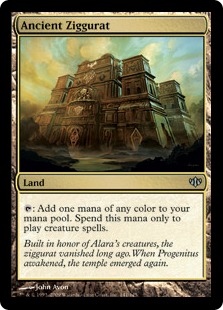
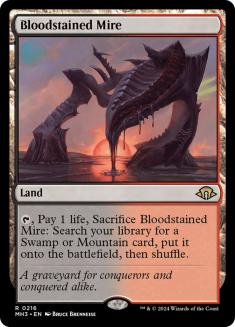
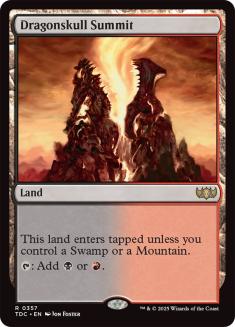
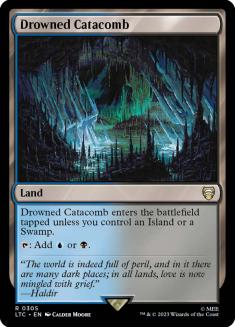

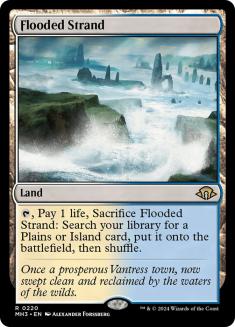
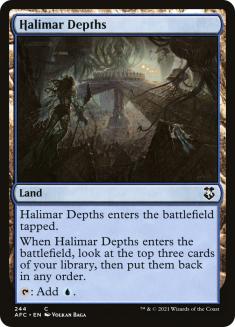
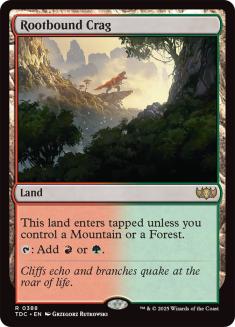
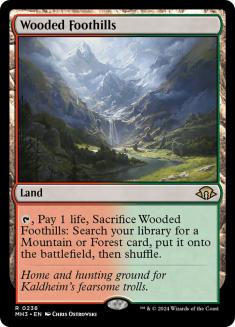

In
(8):


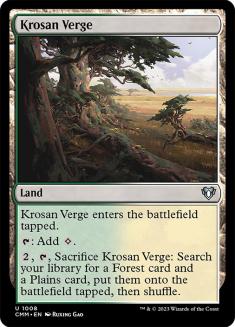
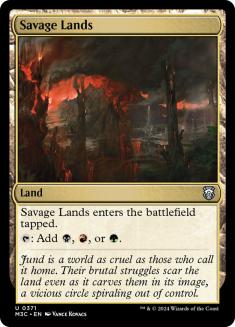

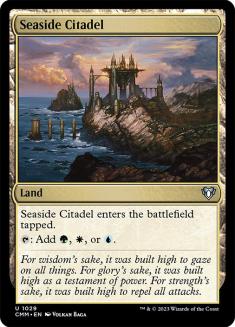
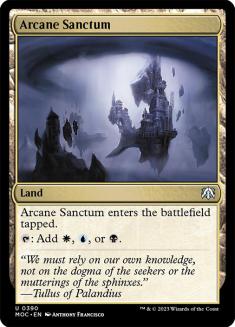
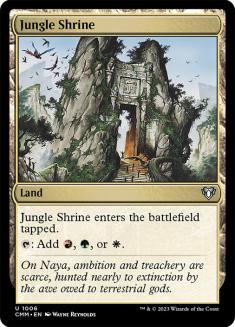
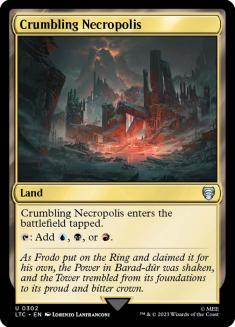

Normally I’m light on the land section, but there were two things here I felt I wanted to change. I also wanted to say “to correct” just now, but that
would imply I’m right, when the truth is that there’s clearly room to disagree, particularly when discussing five-color manabases.
To start, I’m a fan of including the Ravnica cycle of typed-nonbasic lands. When you can use Eternal Dragon to nab any color you’re missing, that
card gets a lot better. Farseek gets a lot better. Wood Elves gets a lot better. All of those points would be true for the original dual lands as well, but
players tend to assume degeneracy when you’re building your deck on the back of a Legacy manabase.
Since you were using typed lands, I decided to bring in Krosan Verge. This card shines in these sorts of manabases. Since Krosan Verge doesn’t specify
basic lands, you can use it to add four colors of mana to the board while ramping yourself ahead a land. That’s pretty cool; cooler is that you can tap it
for mana if you don’t have time that turn to use its ability. It’s a little slow, but I think that’s okay when you have such a strong endgame.
I also like running 40 lands in this type of deck. My Scion of the Ur-Dragon deck runs the same number, and I’m usually a 38-or-37-lands type of woman.
Typically I dislike flooding out, but Scion of the Ur-Dragon wants to be drawing lands on the regular, even after you start tutoring them out with ramp
spells like Cultivate and Farseek.
Cultivate made me want this deck to run a few more nonbasics. I brought your Forest count up to three to help with casting the green ramp cards that will
help fix your mana, and your Island count up to three, so you could cast cards like Niv-Mizzet, Dracogenius off of basic lands. If there were one extra
land slot, I’d put in a third Mountain as well, so that you could cast all the cards in your deck off basic lands in a pinch; if that seems appealing to
you, it might be worth cutting Temple of the False God in its place. Again, I stress the “might” here, because getting to six mana on your fourth or fifth
turn seems like it would be great for a deck like this, but at the same time, Temple of the False God doesn’t help you with your rather demanding color
requirements.
You had a couple of mixed duals in the final five slots. I loathe asymmetry in manabases. It is completely irrational, but at the same time it means I can
pick up a deck I haven’t played for a while, or lend one of my decks out to a stranger, and we’ll have a decent sense of what the manabase looks like after
we’ve drawn our hand. Fetchlands, while good when paired with the Ravnica duals, demand ten slots to complete the cycle, all while drawing plenty of aggro.
Perhaps they’d be worth keeping in if you were running Crucible of Worlds, Life from the Loam, and some sort of self-mill theme, but I don’t think they’re
worth it barring that specific subtheme.
Ramps
Out
(8):
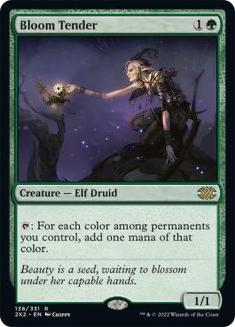
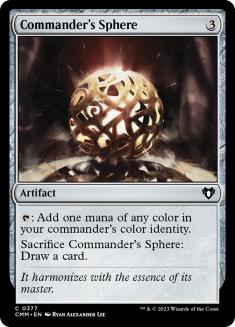
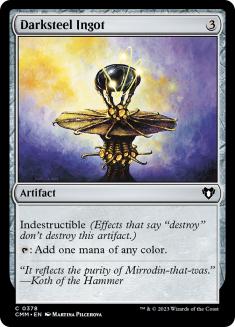
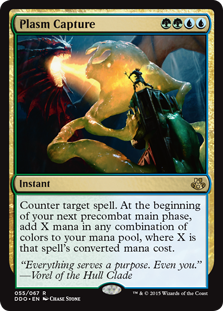

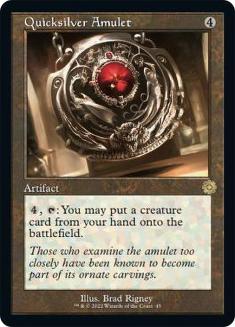
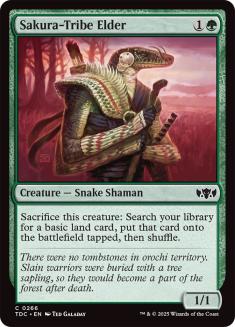
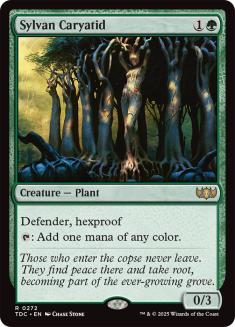
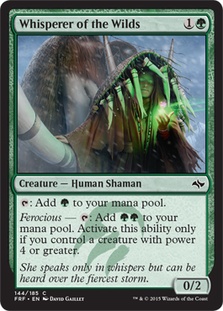

In
(2):
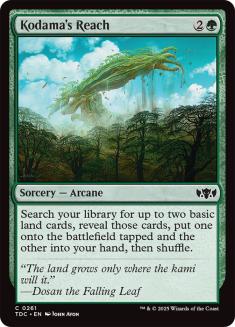
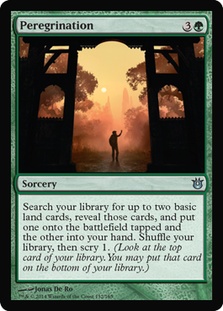

In a deck like this, your first response to getting wiped out by some End Hostilities or Wrath of God is going to be to recast your commander. This is why
I dislike mana-generating creatures. At the point in the game you’re most likely to need them, that’s when they’re in the graveyard. Even mana rocks like
Commander’s Sphere and Darksteel Ingot can end up being wiped out by a card like Merciless Eviction, although at least you get a card out of the
Commander’s Sphere. While I’ll make exceptions for cards like Sol Ring and Chromatic Lantern, where their vulnerability is far out-weighed by their
utility, I tend to dislike running those second-tier mana rocks unless your deck specifically needs to hit a specific mana point to work.
Instead, I like ramp that involves putting more lands out on the battlefield. Given this, you could reasonably keep in Sakura-Tribe Elder, as it has
synergies with Living End, but I think the card is a little weak unless you happen to draw that particular spell. Instead, I like my ramp spells to put me
ahead on cards. That’s why I suggest supplementing your Cultivate with Kodama’s Reach, and then going one step further and bringing in Peregrination as
well.
Peregrination could, and perhaps even should, be Explosive Vegetation. It’s newly reprinted, and it puts both lands out on the board. But I feel like when
I topdeck a ramp spell in the lategame, I often don’t have any lands in my hand. In that situation, an untapped land in hand is often better than an extra
tapped land on the battlefield, since I can effectively recoup a mana from the spell by playing the tutored land. If you have something else to do that
turn, that one mana can be make or break.
Walls
Out
(1):
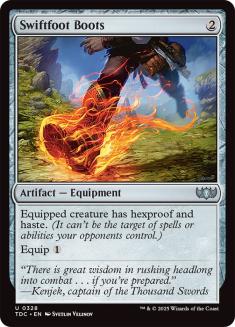

In
(1):
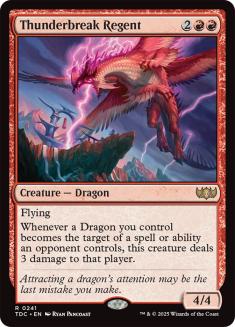

Here you can start to see the major shift I made to the deck: the addition of cheaper Dragons. Cheaper in mana, that is; several of the cards I added are
currently seeing play in Standard as well because Dragons are awesome. But I wanted to move towards synergy at the cost of individual power spikes.
Swiftfoot Boots are powerful, yes, but you’ve already got more powerful ways to give your creatures haste. Temur Ascendancy, for example, grants haste
while doubling as a draw engine. Karrthus, Tyrant of Jund grants haste while obtaining dominion over other Dragons. Swiftfoot Boots does it while adding
hexproof, an ability I think that tends to draw more aggro towards your permanents.
I mean, think about it. If you go to put Swiftfoot Boots on Scion of the Ur-Dragon, someone’s going to try to kill Scion. It would be folly not to! Since
you’re demanding they make a play decision based on imperfect information, they’re going to assume the worst. If you instead wait for them to make the move
before tutoring up something like Dragonlord Ojutai or Quicksilver Dragon, often having to respect that means they won’t kill Scion at all. Between the
time you would have equipped the Boots and the time that you do something cool with Scion of the Ur-Dragon, someone else may have drawn out that removal
spell. Maybe they tried to equip a terrifying creature with Lightning Greaves, forcing the third opponent to choose between a Scion of the Ur-Dragon that’s
just hanging out and can probably protect itself or an actively terrifying creature that is soon going to be out of the line of fire. In that situation,
the hypothetical Blightsteel Colossus is going to draw the removal, even if long term, the Scion is more of a threat.
Assuming someone could survive a hasted Blightsteel Colossus that’s immune to spot removal. It’s been known to happen, but that’s why I don’t like when
people play that card.
Anyway, instead I put in Thunderbreak Regent. It protects your team by making it unpleasant to target them, but without forcing anyone to respond to it or
lose their window. It’s a softer protection, based more on the interpersonal dynamics of the table, but it’s also a 4/4 Dragon that plays wonderfully well
with the Fate Reforged legendaries. It also protects your face, since a 4/4 flier on defense on turn 3 or 4 usually keeps you safe from the random
attacks of opportunity that nibble away at anyone who’s slow to raise their shields.
Bodies
Out
(1):
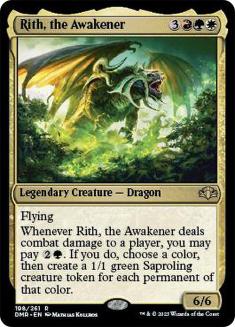

In
(4):
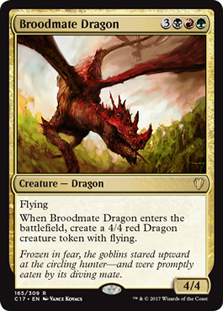
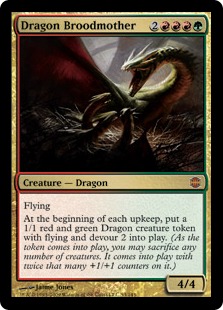
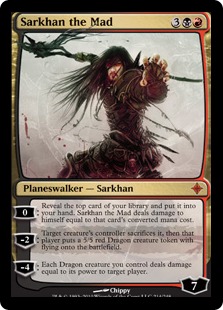
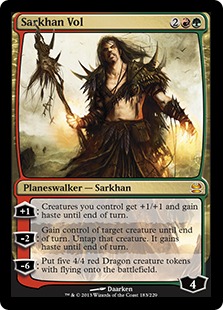

Still, haste is a useful ability, even if I’m not a huge fan of the singular aspect of Swiftfoot Boots. I didn’t want to lower you on speed enablers for a
deck centered around terrifying Dragons, known for swooping in before a town can react. That’s where Sarkhan Vol came in.
Rith, the Awakener, is a weird token generator. Perhaps it’s because that Dragon was sired during my donut hole in Magic participation, but I’ve never been
a huge fan of having to pay three mana in addition to connecting with an opponent’s face in order to make some Saprolings. And Rith is basically the best
one of that whole cycle. Unless you count the Planar Chaos ones, in which case Teneb, the Harvester clearly wins the whole thing.
Instead of having to jump through hoops for variable Saprolings, I wanted cards like Sarkhan Vol and Sarkhan the Mad that could make Dragons and also have
a secondary effect. Sarkhan Vol is a haste enabler, and Act of Treason that ultimates into a flock of Dragons. It’s pretty cool. Sarkhan the Mad makes
Dragons, but he also draws you cards and occasionally lets your whole team smack an opponent in the face. These are all relevant abilities, and they’re all
on-theme.
Dragon Broodmother is a more direct upgrade to Rith, the Awakener. Harkening back to the most iconic Saproling generator, Verdant Force, Dragon Broodmother
gives you a token during every player’s upkeep. These tokens are already better for the deck by virtue of being fliers and Dragons, but they have devour as
well. There are situations in which that is a very useful ability.
Of course, Dragon Broodmother is a bit slow and draws a ton of aggro. More reasonable is Broodmate Dragon. For six mana you get Double Dragons, one of whom
doesn’t die to Doom Blade, not that it’s the spot removal you really have to fear. It’s powerful without being super aggressive, and that’s the ratio you
want to shoot for when you’re trying to sculpt your threat profile.
Graveyards
Out
(4):
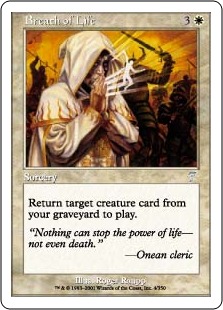
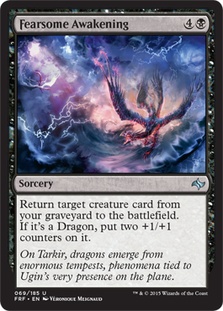
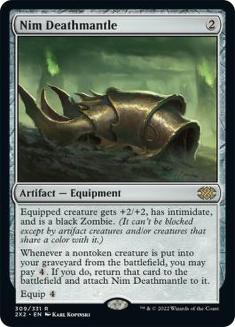
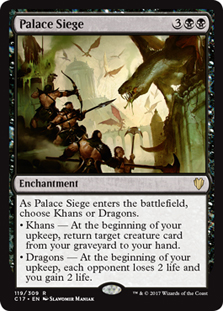

In
(1):
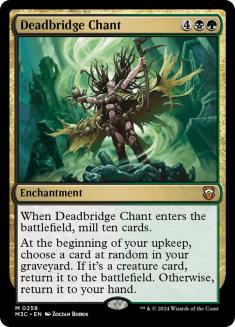

When selecting my individual reanimation spells, I tend to have a rough order of preference. I like Unburial Rites, Dread Return, and Tempt with
Immortality first tier, followed by Reanimate and Exhume. Breath of Life, while a standout in my Pauper Cube, is a one-for-one. Commander is too focused on
card advantage to feel great running those. Same goes for Fearsome Awakening, although I had some regret cutting this one due to its tribal themes and
obvious interaction with Scion of the Ur-Dragon.
Nim Deathmantle is a strong card, but most people run it for the combo potential. As such, I worry that it draws too much aggro. Perhaps if it were more
on-theme, it would be more debatable, but as is, I felt fairly resolute as I cut it.
Finally, there’s Palace Siege. I have been so underwhelmed by this card. If the Dragons side were phrased such that you gained all the life from the
lifesuck, I think it would be a multiplayer All-Star… as is, it feels more like a slower, more expensive take on Oversold Cemetery. It’s been one of the
last cuts in every deck I’ve thought to run it in. It’s close, but only being able to gain two life a turn really puts a lot of pressure on that Khans side
of the card. One of the reasons Frontier Siege is such a strong inclusion in a deck like this is that either side, when named, does something the deck
wants to be doing. Palace Siege can’t make that claim.
Instead, I like Deadbridge Chant. It’s powerful, random card advantage. It helps fill your graveyard when it drops, powering up your reanimation spells
while also reanimating or drawing you a card every one of your upkeeps. It’s a shame it’s constricted by its Golgari color identity; were this card
mono-black, I’d be able to run it in many more decks.
Erasers
Out
(6):
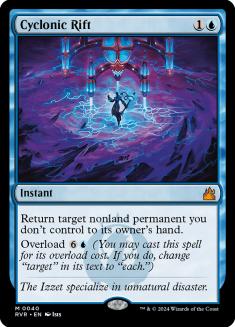
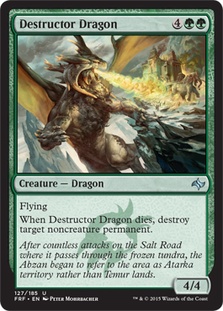
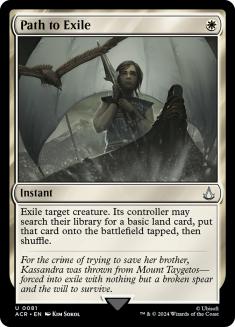
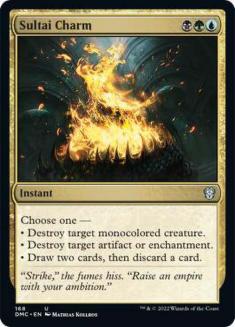
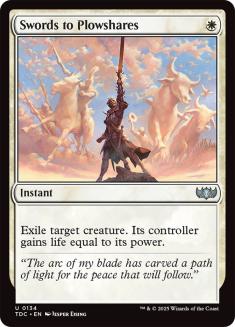
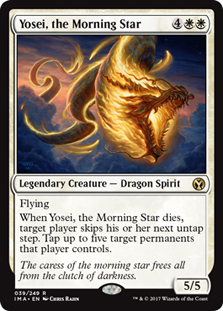

In
(9):
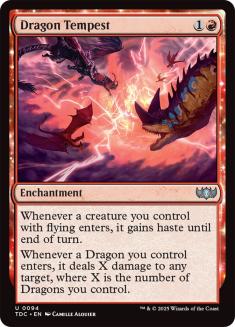
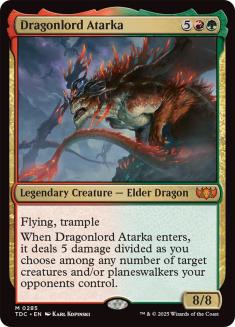
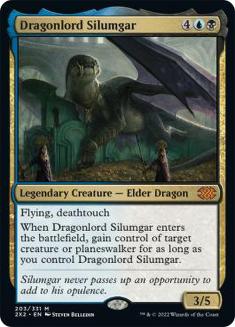
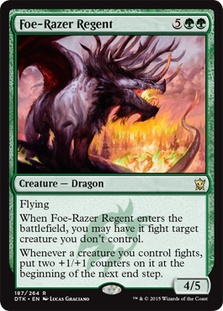

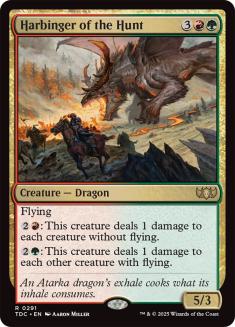
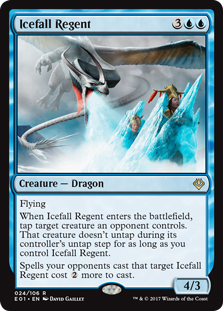
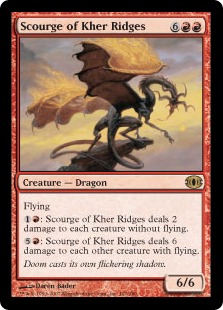
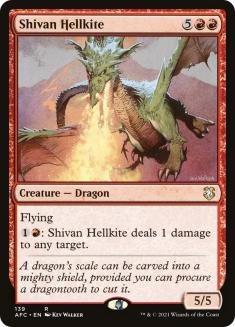
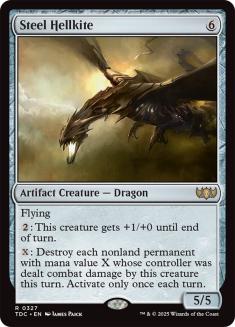

What I cut is a little less interesting than what I added, so I’m going to power through. Destructor Dragon and Yosei, the Morning Star were both cut
because I don’t love death triggers in a Scion of the Ur-Dragon deck. Since the death trigger doesn’t happen if you put your commander back into the
command zone, you can’t tutor one of them up in response to a removal spell, which is what I usually want to do with cards like that. Plus, it’s better to
keep your cards on the table! That’s what synergy is for.
Path to Exile and Swords to Plowshares are both one-for-ones, at best. Sultai Charm has modes but is not otherwise on-theme with the rest of the deck. I
think it’s one of the better charms, but I don’t think it’s the best modal instant in all the five colors, nor do I think that’s something this deck wants
anyway.
As I’ve mentioned before, Dragons are great at killing things. Given that, there are a lot of tribal removal options. And that’s where Scion of the Ur-Dragon personally excels.
The downside to a card like Steel Hellkite is that people are very reluctant to let it hit them. Swing at them with Scion, though, and not only do they
have to face a situation where they likely don’t have a great block, but where you might pop some of their prized permanents if it should connect.
Forking people can be fun.
Dragon Tempest is another haste enabler, which means this version has more haste than the original, even without the Swiftfoot Boots. But that’s not why
I’m including it. I’m including it because its second ability mirrors that of Scourge of Valkas, and that ability is very powerful to begin with. Not only
can you hit someone in the face with your enters-the-battlefield trigger, but you can use it to gun down the creatures getting in your way. Priceless!
The Dragonlords are, with one glaring exception, good in Commander. They’re not super exciting as cards go, and I think they make for poor commanders due
to the vanilla flavor of their abilities, but there’s no shame in running them in your 99. Even Dragonlord Ojutai draws you cards, although that’s nothing
compared to Dragonlord Atarka’s removal or Dragonlord Silumgar’s impression of Sower of Temptation.
The less said about Dragonlord Kolaghan the better.
Foe-Razer Regent comes in because it’s really good with Frontier Siege. I still think it’s tribally relevant without that interaction since at the very
least it comes in and fights something, but when you add in that axis of attack it becomes a very strong card indeed. Scourge of Kher Ridges is another
big-drop with a removal ability to match, although Scourge is further advantaged by how well it plays with Scion of the Ur-Dragon. Tutor it up, wipe the
rest of the skies, and you’re still left with your powerful commander… and the eight mana required by this line of play.
Shivan Hellkite offers a bad rate of return given the ability, but what it does offer is a mana sink. If you’ve held Scion back for defense, but the threat
alone has deterred the reason you were holding up the ability, you can swap into Hellkite at the turn end prior to your upkeep and use that mana to cut up
the boardstate. Pretty cool.
Finally, we have Icefall Regent and Harbinger of the Hunt. When these Dragons were first spoiled, I was skeptical of their power level, and rightly so.
These are not particularly powerful cards. The Regent is worse than Ojutai, Soul of Winter (already in the deck), and the Harbinger is worse than Scourge
of Kher Ridges (just added to the deck). But they’re something neither of those cards can claim to be: They’re five mana. And a five-mana Dragon is going
to hit the table relatively quickly.
Others
Out
(1):
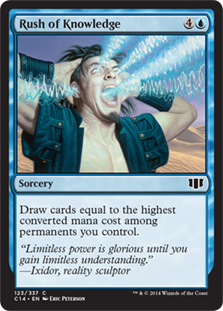

In
(4):
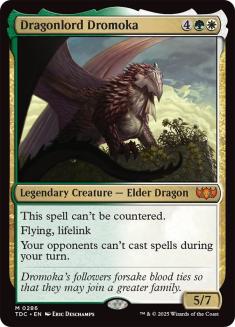
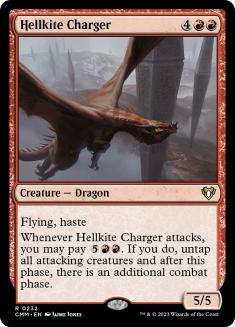
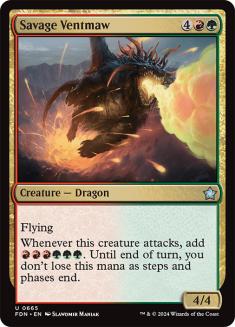
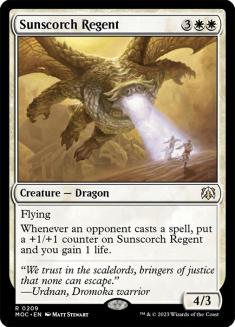

Hey, Sunscorch Regent is five mana too! What a coincidence that it too has made its way into this build. Actually, I really have come around on the
Sunscorch Regent as a multiplayer card. It gets bigger and gains you life, and both of those things can be very relevant, particularly if you drop this
thing early on. I worry that it will draw disproportionate amounts of aggro, but any removal spell this thing eats is one that’s not targeted at Scion of
the Ur-Dragon.
Plus, if you happen to be playing against storm and they start to combo off, tutor up this guy and their job gets a little harder.
In general, though, I feel that lifegain is underappreciated in Commander. Sometimes you’re going to have to take a hit from something big. It’s just the
way these things go! And when you do, being able to heal gives you breathing room. That’s why I also added in Dragonlord Dromoka. I think she’s relatively
low-impact, as Dragonlords go, but she’s also a 5/7 lifelinker. That’s enough toughness to survive most of the damage-based removal spells (short of
Skred), and she makes a great blocker to boot. That meets my bar for inclusion, although I’d cut her without remorse down the line if they keep printing
sweet Dragons.
I somewhat suspect we won’t see many of them in the near future since R&D might reasonably be Dragon’d out, but they’ve certainly raised the bar for
the ones they do print.
Hellkite Charger and Savage Ventmaw make up a sweet new Dragon combo, but I think it’s not an overly oppressive one since it can be repelled by a strong
aerial defense and isn’t easily infinite. It would be one thing if either of the creatures could stay back and still give you the effect, but they’ve got
to scrap it up for it to go off, and there are plenty of ways to kill a 4/4 when it attacks you.
Finishers
Out
(3):
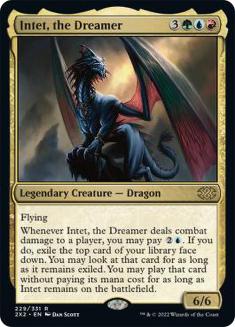
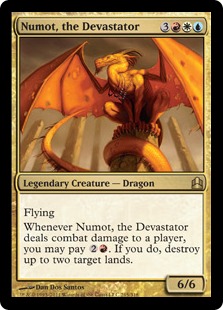
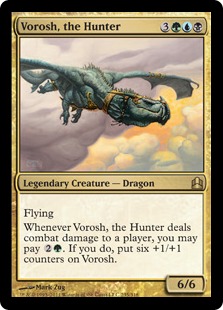

In
(3):
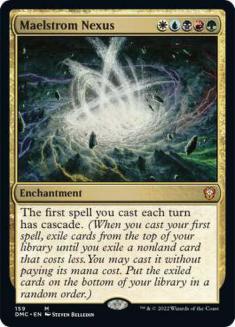
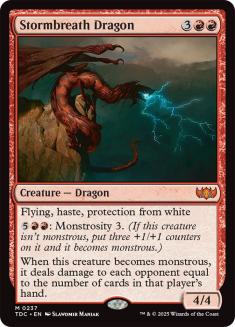
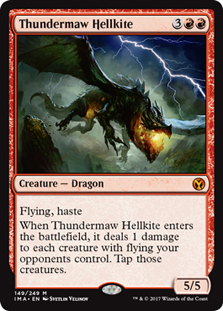

As I mentioned above, I’m not a huge fan of the cycle of Dragons that require contact with the opponent and three mana in order to do something. Those are
non-negligible trigger conditions! When I manage to connect with a card like that, I want more than a random free card from the top of my deck, or a power
and toughness boost, or even bombing my opponents’ lands. Reanimating the best card in any graveyard, though, is exactly the type of high-reward play
that’s worth jumping through all those hoops. Especially when you can activate an unblocked Scion, hold priority, and activate again. For the first
resolution of the ability, you dump a card you want to reanimate into your graveyard, and then on the second resolution, you morph into Teneb, the
Harvester to reanimate your prize.
That’s a cool line of plays, right? If your opponent is terrified, you’re going to one-shot them with Dragon Tyrant; they’re never going to leave you the
opening to do something like that.
Thundermaw Hellkite is a five-drop Dragon, which is worth considering on its own. It also wipes out Spirit tokens and taps your opponents’ defensive
fliers, however. It’s a good combination of abilities, and it’s easy to remember why this card once ruled Standard. Currently having a major impact on
Standard, Stormbreath Dragon is worth including because its monstrous abilities reads “each opponent.” I love that phrase, “each opponent.” That it has
haste and protection… well, that’s just icing on the cake. It’s nice to have an answer to all those Swords to Plowshares and Oblivion Rings.
Finally, there’s Maelstrom Nexus. I’ll be honest, I tend to throw this card into anything running five colors. So long as you’re casting spells, Maelstrom
Nexus lets you get twice the utility out of your first spell each turn, and that makes these decks play out a bit like Maelstrom Wanderer decks tend to.
By which I mean they play out awesome.
Creatures (37)
- 1 Solemn Simulacrum
- 1 Shivan Hellkite
- 1 Kokusho, the Evening Star
- 1 Wood Elves
- 1 Quicksilver Dragon
- 1 Eternal Dragon
- 1 Dragon Mage
- 1 Bladewing the Risen
- 1 Teneb, the Harvester
- 1 Scourge of Kher Ridges
- 1 Broodmate Dragon
- 1 Karrthus, Tyrant of Jund
- 1 Dragon Broodmother
- 1 Hellkite Charger
- 1 Steel Hellkite
- 1 Hoard-Smelter Dragon
- 1 Thundermaw Hellkite
- 1 Niv-Mizzet, Dracogenius
- 1 Utvara Hellkite
- 1 Scourge of Valkas
- 1 Stormbreath Dragon
- 1 Scourge of the Throne
- 1 Kolaghan, the Storm's Fury
- 1 Dromoka, the Eternal
- 1 Silumgar, the Drifting Death
- 1 Atarka, World Render
- 1 Ojutai, Soul of Winter
- 1 Dragonlord Silumgar
- 1 Sunscorch Regent
- 1 Harbinger of the Hunt
- 1 Dragonlord Atarka
- 1 Foe-Razer Regent
- 1 Thunderbreak Regent
- 1 Dragonlord Dromoka
- 1 Dragonlord Ojutai
- 1 Savage Ventmaw
- 1 Icefall Regent
Planeswalkers (3)
Lands (30)
- 1 Reflecting Pool
- 2 Swamp
- 1 Temple of the False God
- 1 Krosan Verge
- 1 Overgrown Tomb
- 1 Sacred Foundry
- 1 Temple Garden
- 1 Watery Grave
- 1 Godless Shrine
- 1 Steam Vents
- 1 Stomping Ground
- 1 Blood Crypt
- 1 Breeding Pool
- 1 Hallowed Fountain
- 1 Arcane Sanctum
- 1 Crumbling Necropolis
- 1 Jungle Shrine
- 1 Savage Lands
- 1 Seaside Citadel
- 1 Exotic Orchard
- 1 Cavern of Souls
- 1 Opal Palace
- 1 Nomad Outpost
- 1 Mystic Monastery
- 1 Sandsteppe Citadel
- 1 Opulent Palace
- 1 Frontier Bivouac
- 1 Crucible of the Spirit Dragon
- 1 Haven of the Spirit Dragon
Spells (29)
- 3 Forest
- 2 Plains
- 1 Living Death
- 1 Sol Ring
- 2 Mountain
- 2 Island
- 1 Kodama's Reach
- 1 Patriarch's Bidding
- 1 Farseek
- 1 Maelstrom Nexus
- 1 Cultivate
- 1 Command Tower
- 1 Chromatic Lantern
- 1 Deadbridge Chant
- 1 Bow of Nylea
- 1 Tempt with Discovery
- 1 Peregrination
- 1 Temur Ascendancy
- 1 Crux of Fate
- 1 Frontier Siege
- 1 Monastery Siege
- 1 Dragon Tempest
- 1 Dragonlord's Prerogative
- 1 Silumgar's Scorn

What I like the most about this build is that it’s now running 37 creatures. Creatures make up the backbone of any proactive deck, and that’s particularly
true when you’re planning on taking advantage of cards like Patriarch’s Bidding or Living Death. A little over one in three cards isn’t a terrible place
for your creature count to be.
Here’s the price breakdown. Fair warning, given that Ignas didn’t specify a budget,
and Cassidy put Nether Void in a list just last week
, I didn’t consider the budget when making this build. I still ended up with something on the high end of reasonable, but the Standard-playable cards in
particular bent the cost curve.
|
Card |
Price |
|
$0.00 |
|
|
$0.00 |
|
|
$0.25 |
|
|
$0.39 |
|
|
$0.39 |
|
|
$0.49 |
|
|
$0.49 |
|
|
$0.49 |
|
|
$0.69 |
|
|
$0.75 |
|
|
$0.89 |
|
|
$0.99 |
|
|
$0.99 |
|
|
$0.99 |
|
|
$1.05 |
|
|
$1.29 |
|
|
$1.39 |
|
|
$1.49 |
|
|
$1.69 |
|
|
$1.79 |
|
|
$3.75 |
|
|
$4.19 |
|
|
$7.89 |
|
|
$8.99 |
|
|
$9.55 |
|
|
$10.09 |
|
|
$10.29 |
|
|
$11.45 |
|
|
$11.99 |
|
|
$14.15 |
|
|
$14.79 |
|
|
$18.95 |
|
|
Total |
$142.58 |
As you can see, $143 is a bit much, but I think it’s not that bad in the grand scheme of things. The Standard relevant cards should be easy to buy or trade
for, and waiting on them drops the total back below $100… even without taking into consideration the $20 store credit received by anyone whose submission
is chosen as the deck of the week on Dear Azami. If you want to try your shot at an interesting submission, email us at DearAzami [at] gmail [dot] com.
That’s it for this week. Let’s all wish Cassidy a warm welcome back to the column, and tune in next week for more of the same!
Want to submit a deck for consideration to Dear Azami? We’re always accepting deck submissions to consider for use in a future article. Only one deck
submission will be chosen per article, but being selected for the next edition of Dear Azami includes not just deck advice but also a $20 coupon to
StarCityGames.com!
Email us a deck submission using this link here!
Like what you’ve seen? Feel free to explore more of Dear Azami here, in the Article Archives!
And feel free to check Jess’s own Command of Etiquette
column on Hipsters of the Coast, for more Commander and casual content. Now on Thursdays!


